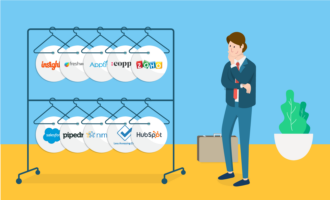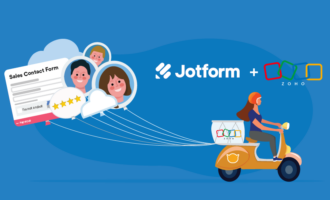Top 10 tools for customer communication
From chatting with prospects and customers on the phone to gathering feedback after each support interaction, great communication is key to a successful business.
Fortunately, there’s a wide variety of communication tools customer support teams can use to improve customer communication.
In this post, we’re sharing information about some of the top customer communication tools:
Online forms and surveys
- Jotform
- SurveyMonkey
- Google Forms
Live chat tools
- Drift
- Intercom
Virtual calls and meetings
- Slack
- Zoom
- GoToMeeting
Self service hubs
- Zendesk
- HubSpot CRM — Service Hub
Online forms and surveys
Having customers fill out surveys provides valuable feedback your organization can use to make improvements. Here are some of the top free and paid survey tools to help you collect data from your customers.
1. Jotform
Whether you need to collect contact information, waivers, feedback surveys, or anything in between from customers, Jotform’s easy-to-use drag-and-drop Form Builder is a helpful tool.
In fact, Jotform has hundreds of free customer feedback and survey templates you can use to get started. You can create a form for free. Advanced features, such as conditional formatting, are available to all users.
Paid plans start at $34 per month when billed annually, and nonprofits can get a 50-percent discount.
2. SurveyMonkey
SurveyMonkey lets users gather and measure customer feedback through surveys, quizzes, and polls. You can create these with templates and collect responses through web links, email, social media, or mobile chats. SurveyMonkey automatically analyzes results, which you can export or integrate with other apps.
Launched in 1999, SurveyMonkey has grown from the founder’s part-time project to the world’s most popular, free online survey tool. While the free basic plan offers unlimited surveys, premium plans have more robust features — like unlimited questions per survey. Paid business plans start at $25 per user, per month.
3. Google Forms
Google Forms allows users to design customizable surveys, quizzes, and polls that can include logos, images, and videos. Forms are responsive, automatically collect data, and make the information viewable in sheets. It’s also simple to add collaborators to a form.
Google Forms began as a feature of Google Sheets back in 2008. Today, it’s offered as part of Google Drive or Google Classroom alongside Google Docs, Sheets, and Slides. Google Forms is free for anyone to use through a personal account.
Live chat tools
Live chat tools let customer service teams converse with customers anytime. Instead of filling out a contact form and waiting, customers can connect with support the moment they’re ready. Here are some live chat tools that make that possible.
4. Drift
Drift’s live chat function helps businesses engage with their customers right away. Features include targeting, routing, and the ability to book meetings.
Drift began in 2015 and is one of the premier live chat tools available today. The free plan gives users access to the live chat feature. The ability to use custom bots is included in premium features that start at $2,500 per month.
5. Intercom
Intercom made its live chat feature to target different audiences with tailored messages. Customer support teams can provide real-time support at scale with automation, proactive self-service, and a collaborative inbox. Interactive tours are available through live chat to further improve the customer experience.
Intercom came on the scene in 2011 when it became the world’s first conversational relationship platform. Today, it offers free trials for many of its plans. Plans begin at $39 per seat/month for a basic live chat and outbound messaging capabilities.
Virtual calls and meetings
Due to their flexibility and convenience, virtual meetups can be even more effective than meeting in person. Here are some helpful tools that make organizing virtual discussions a breeze.
6. Slack
Slack is a useful tool that can make customer help desks thrive. Support teams use Slack for automation, issue resolution, knowledge sharing, and collaboration. It allows teams to speak with customers directly through audio or video calls. The software seamlessly integrates with tools like Intercom, Drift, SurveyMonkey, and Zendesk.
Slack began in 2009 and has since become one of the fastest-growing software companies around. Small teams starting out can use the basic version of Slack, which is free. Paid plans, which include features like face-to-face group calls, start at $7.25 per month.
6. Zoom
Zoom offers video conferencing with real-time content sharing and messaging on any device. You can make individual or group calls through audio and video. This tool makes it easy to join and host meetings. Recording and transcripts are added options you can use to help keep track of what callers have discussed, making Zoom an excellent choice for customer support conversations.
Though Zoom has seen wide use since its start in 2011, the company has recently gained an influx of new users as more teams turn to remote work. Personal meeting plans are free, but paid plans with additional features — like longer group meeting capabilities — begin at $13.33 per month.
7. GoToMeeting
GoToMeeting is a popular platform for hosting virtual meetings. This simple meeting solution has many practical features like screen sharing, drawing, messaging, meeting transcription, slide capturing, unlimited recording, and more.
GoToMeeting started back in 2004, and support teams use it today to connect with customers. Plans begin at $12 per month.
Self-service hubs
Customer relationship management systems (CRMs) are databases that support teams use to store customer information, interactions, and transactions. Here are a few that are designed to make customer interaction simpler.
8. Zendesk
Zendesk’s Support Suite works to foster natural conversations between support teams and customers. Features include live chat, voice and SMS, self-service and knowledge base, social messaging, and the ability to track and prioritize interactions.
Zendesk got its start in 2007 as a service-first CRM company. Today, it still focuses on software designed to improve customer relations. Pricing starts at $55 per agent, per month, billed annually.
9. HubSpot CRM — Service Hub
HubSpot CRM for customer service allows users to manage all customer communication in a universal inbox. Ticketing, live chat, and shared team email are a few of the available features.
HubSpot got its start in 2006 and offers a wealth of tools for customer service teams. The company offers free CRM plans as well as paid plans with more advanced features. Pricing for Service Hub starts from $90 per seat per month.
***
Integrating the right tools into your business can greatly improve communication with your customers. However, there is no one-size-fits-all solution to customer service. Carefully compare your options and take advantage of free trials to determine which software is a good match for your company.


















































Send Comment:
1 Comments:
More than a year ago
you create a more storng build strong customers relation. i using zoom app and slack its amazing .i appcriate your work .Thanks!